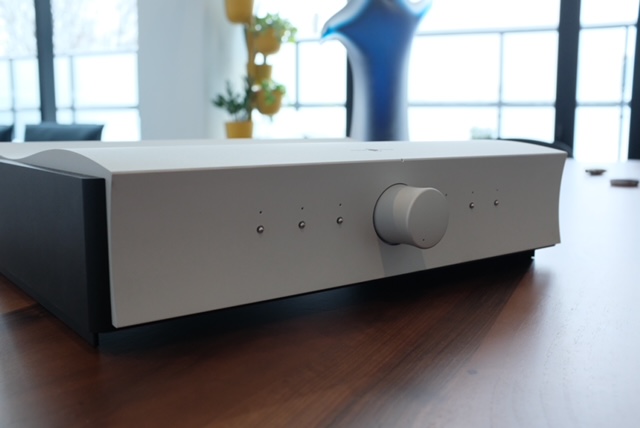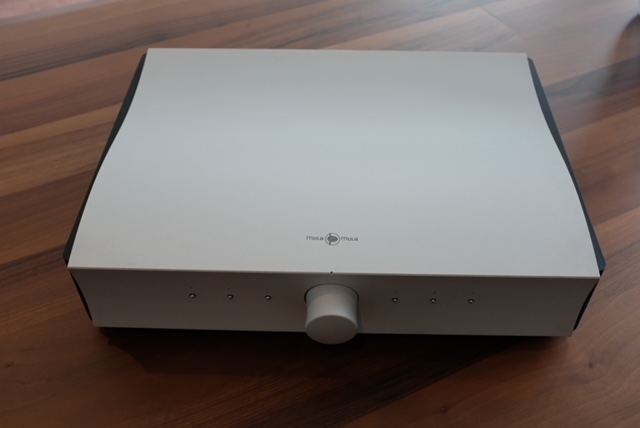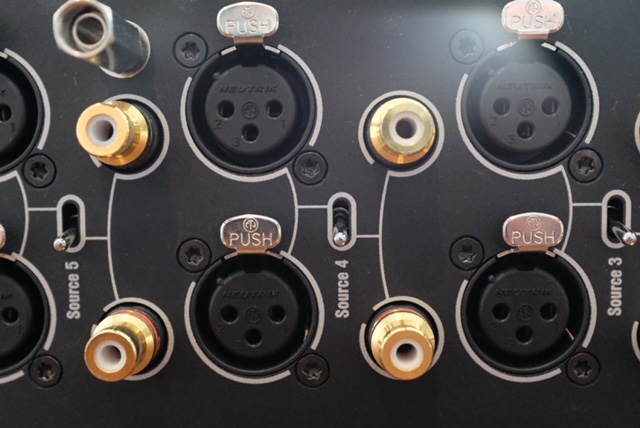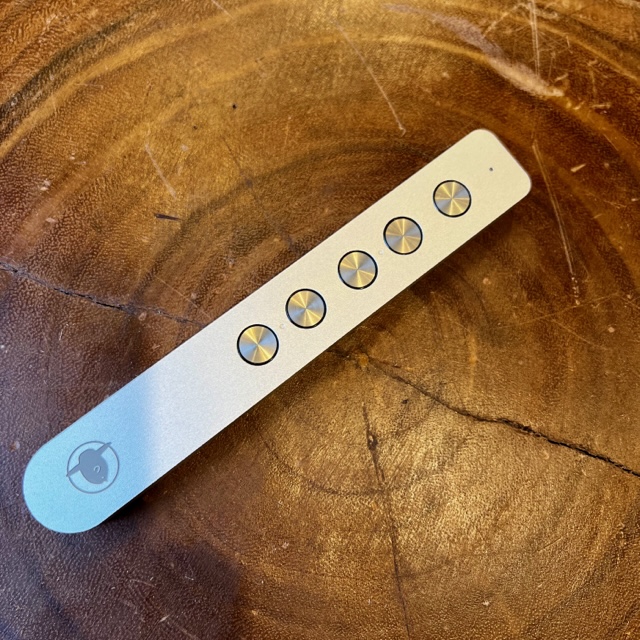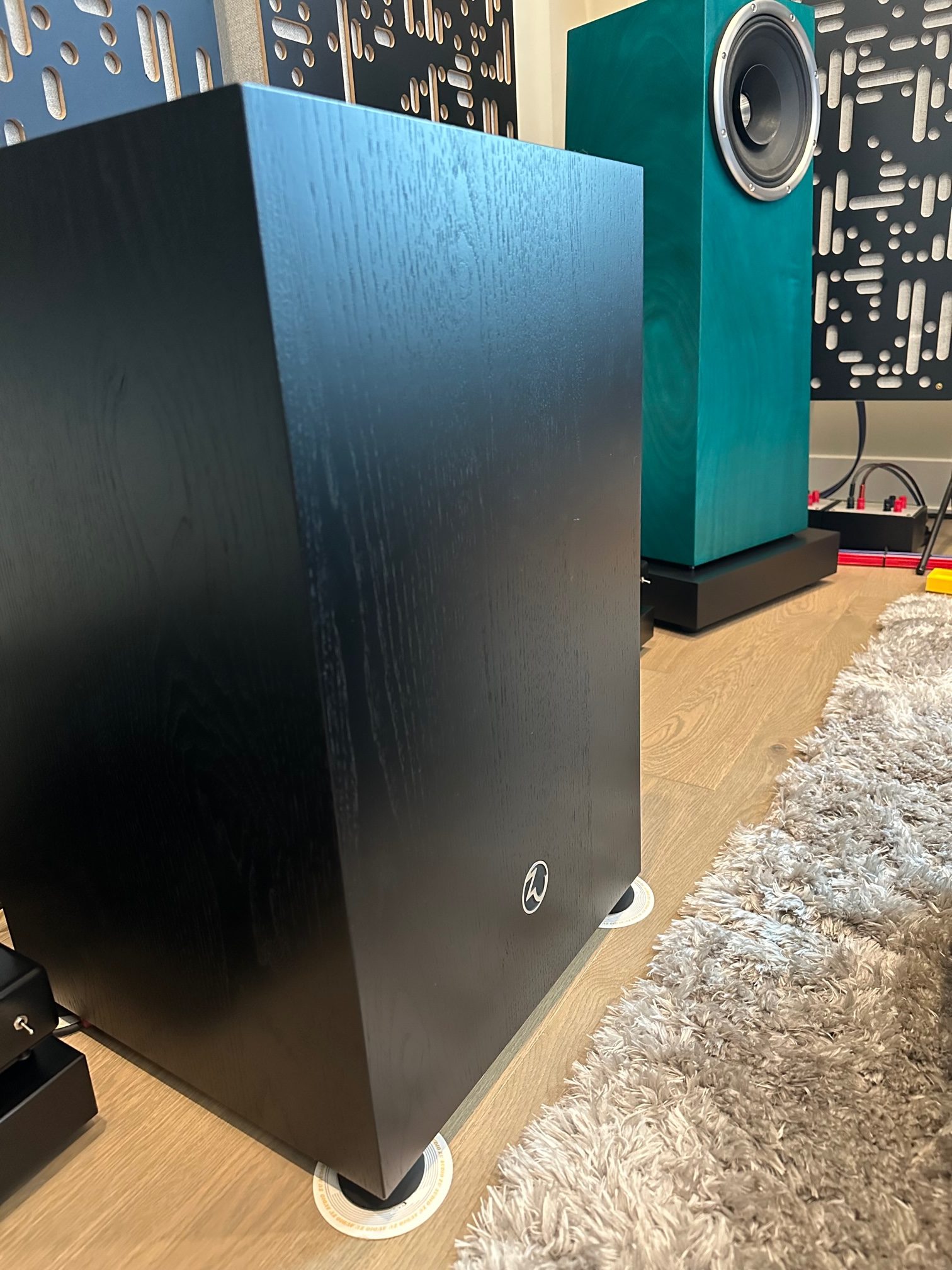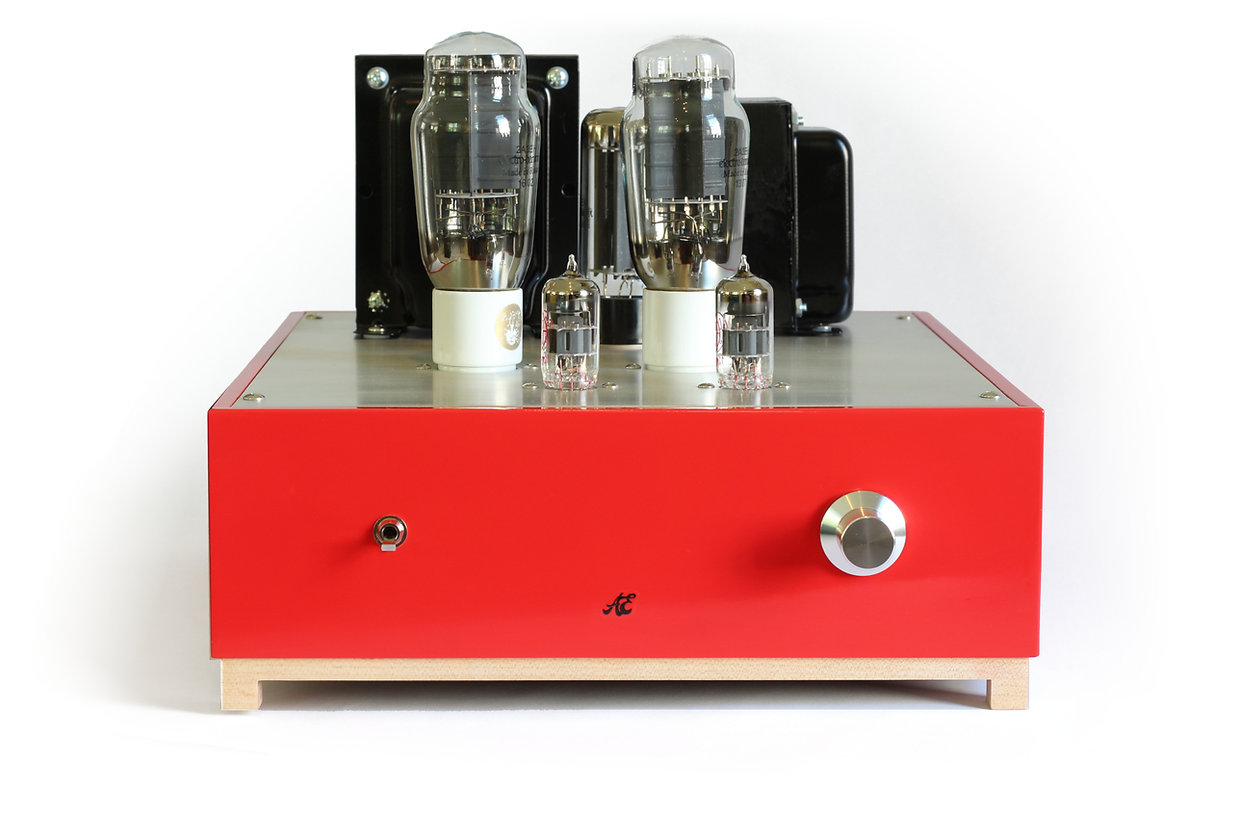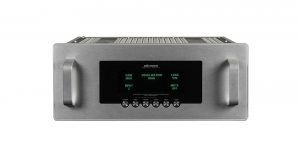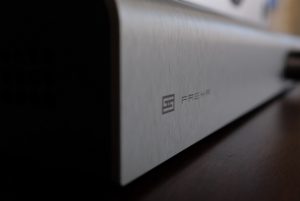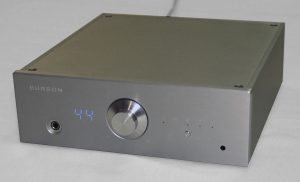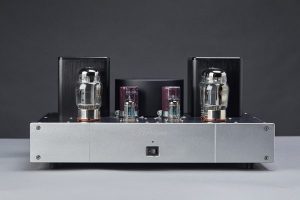On Mola Mola's website if you click on the Makua, the first thing you will notice is "Analog Design for a Digital Age" in bold under a picture of the Makua. It was this statement that first interested me in the Makua, and caused me to reach out to Mola Mola's US distributor for a review sample.
I am what many would describe as "digital audiophile." I grew up in a time where all of the music around me was on shiny discs. I listened to my first album from end to end on an iPod mini in a horrendously lossy format. I skipped buying CDs and went straight to MP3s. I believe that music, and the playback of music, should be convenient and easy. As I began my journey to becoming a more serious audiophile, I found it strange that it seemed like the more money you spent, and the better a component sounded, the worse the user experience would be for that component. High End audio meant sound got better, but it seemed like the customer experience got worse. This is incredibly disappointing honestly, and to an extent explains why many of my peers are not willing to take the journey to truly awesome sound with me. "I want something that just works, not a project that I have to baby and care for" is the statement I hear from my audiophile curious friends.
Getting back to Mola Mola, I was curious if the Makua, with its digital control and configuration features, something rarely seen in a high end pure analog pre-amp, could finally deliver the user experience alongside the auditory experience worthy of its price tag. I am incredibly happy to say that Mola Mola delivered, and managed to make an analog preamp with a ton of configurability not only accessible, but dare I say it, enjoyable to use. Their application is well thought out, the configuration options offered by the Makua are awesome and make it an incredibly flexible device. Of course, when configured and connected into your system correctly, it provides a reference analog line stage that easily competes at its price point. Let's talk about why.
Unboxing
The Makua arrived in a hard flight case, and was extremely well protected. The case contained the Makua itself, a power cord, the basic remote (silver Apple remote), the manual, and a set of XLR to RCA adapters.
The Makua is a stunning device. It is carved out of aluminum; the top of the device has a natural curve that reminds me of a wave on the ocean. The bottom of the device is lifted off the ground by two black parallel "skis" that run the length of the Makua. There are rubber pads built into the "skis" that prevent the Makua from slipping or sliding.
The front of the Makua is beautifully simple; the volume control knob is dead center. The knob has a dimple on the front of it so you always know its relative position between min and max, and it is motorized so when you use the remote, or the app, the volume control knob tracks with you. To the left and right of the volume control knob are three buttons (six in total), each of these buttons maps to a specific input/configuration, and is entirely configurable. What is distinctly absent is a digital screen, a menu button, and a direction pad, which is only a plus in my book.
Turning the Makua around, you are presented with five input banks, two outputs, and a set of trigger outputs. Each input bank consists of a single-ended and balanced input, and are switchable via a hard switch on the back of the unit. Even though there is a manual toggle on the back of the unit for each input bank to manually allow you to switch between balanced and single-ended, you can also use the app to switch between the two inputs in each bank. However, according to Mola Mola's documentation there is a greater risk of cross talk if you do this. What this means is that you actually have up to 10 inputs for the Makua, five single-ended and five balanced.
The two outputs are both balanced. Mola Mola strongly believes that balanced interconnects are the best option and recommends the use of balanced interconnects. However, if you choose to you can use the included balanced to single-ended adapters to convert the balanced output to a single-ended output. I did test this and found that the preamp was silent when using the balanced output even at full volume, but had some noise when using it with a single-ended output.
Each input bank consists of a balanced and single ended input, with a hardware switch that allows you to switch between the single ended or balanced input of the bank.
The Makua can be ordered in a variety of configurations; as just a preamplifier, with a phono stage, with a built in Tambaqui DAC, and with both the phono stage and DAC built in. My review unit came with just the phono stage, but the latter two options also would have added a series of digital inputs to the Makua including USB and Network which would expose the Makua as a Roon Ready endpoint. The latter configuration option, while pricey, would allow the Tambaqui to reduce your HiFi rack to a single all-in-one preamplifier just requiring a power amplifier or powered monitors. In all honesty, for someone who has the means and the desire for good sound and simplicity the all-in-one Makua is a logical and excellent choice.
The new Mola Mola remote, now standard with all Mola Mola
My review sample came with the standard silver Apple remote. However, I was informed by Mola Mola that the Makua will now come standard with a new Mola Mola remote control. This is great news as the new remote control, at least on paper, looks better and more functional then the Apple remote. Sadly because I did not receive the new remote with my review sample I cannot comment on its performance, but I was assured it is far better then the old apple remote. I think this great news as I found the idea of paying extra for an upgraded remote at this price point frustrating, and I am happy to see Mola Mola recognize this and fixed it.
The Mola Mola App
The Mola Mola remote app is excellent. I could end there, but I want to tell you more. The app connects to the Makua using Bluetooth. I will be honest and say that this really worried me, first, because Bluetooth pairing process are miserable, and second because traditionally connections that rely on Bluetooth tend to be unstable and less responsive compared to traditional WiFi/hardwired network connections. I am happy to say that none of my concerns came to pass. After downloading the Mola Mola remote app onto my iPhone and iPad, it started up and it found the Makua right away. Clicking on the Makua, I expected to have to go through a pairing process but instead I was given immediate control.
From the app you can control every single function of the Makua, including the phono stage. I really want to underscore this point. If you want to try out a different cartridge loading setting, change it in the app, and hear it in real time. You want to change the equalization curve from RIAA to Decca because you have some old original Who albums, do it and hear the difference. It all just works.
Adjusting volume in the app is a wonderful as well. You can drag the volume slide, and you have two little up and down buttons for fine grain adjustments at half a dB each. Every change to the volume control results in the click of relays, and the movement of the volume control knob on the front of the Makua giving you instant feedback.
The remote app does more though than change volume and allow for input selection, it allows for configuration of how the pre-amp works. Through the app you can configure what happens when you press the front six buttons on the Makua. These buttons are not limited to simply selecting input, but instead can also control the routing within the preamp. For example, lets pretend you have two record players, or possibly two tone arms, one with a moving magnet cartridge and another with a moving coil cartridge. You can plug both into the back of the Makua, and route both inputs through the phono stage. You can then configure the appropriate loading and gain settings for each input and save them as default configuration when switching to that input. Similarly, if you have a single record player, but have a large collection of vinyl that was EQ'd with the Decca EQ and a large collection that was EQ'd RIAA you can map the different EQ configs to separate pre-set buttons. This is the flexibility and ease that I have always been looking for in a preamp, and I am truly excited that Mola Mola delivered this with the Makua.
A Hot Rod of a Phono Stage
I am not going to claim to be a phono stage expert. However, I have listened to many over the course of my audiophile journey, and personally own the WHEST Audio PS.40RDT, which is considered a class leader by those who have heard it. I will say from my personal experience that the 40RDT is the first phono stage that showed me what a high-end analog system can sound like. It was detailed, dynamic, nuanced, and had a naturalness that a digital system simply cannot compete with. Of course, like most High End phono stages, there was no configuration app, and if I wanted to change the cartridge loading or gain this required a full shutdown, allen wrench, and a quick manual check. Let's just say that the WHEST Audio was a set it and forget it kinda device.
The Mola Mola phono add-on for the Makua is advertised as an archival grade phono stage, and for good reason. It is dead quiet and incredibly flexible. It has separate MM and MC gain stages, and its gain can be adjusted in 5dB increments over a 40 dB range. You can also adjust things like the bass shelf, and as I mentioned you can choose from a massive list of EQ curves ensuring that your old vinyl collection is heard the way it was intended to be.
We will talk more about the listening performance of the Makua, but if I were buying a Makua and I had a nice enough analog system, I personally would buy it with the phono stage. It really is that good and competed very well with my more expensive unit from unit from WHEST. When you add in all the flexibility it offers over the WHEST from a configuration perspective, the decision becomes a bit of a no-brainer.
Review System
All equipment for this review has been run for over 200 hours before any critical listening was done.
- Speakers: Zu Soul Supremes, Custom Built Horn Loaded 3-way speakers
- Subwoofers: Two Rel 510s
- Amplification: ampsandsound Zions (Mono-block Citation Vs)
- Digital Source: DCS Rossini, Roon Core
- Analog Source: WHEST Audio PS.40RDT, VPI Classic Signature 3, Fat-gimbal Tone Arm, and AT OC9XSL cartridge.
- Cabling: Wywires and Wireworld, all interconnects were balanced for the purposes of this review.
Setup and Listening Impressions
Getting the Makua set up was incredibly simple. After experimenting with the single ended versus balanced output of the Makua, I wired the entire system as balanced. In this setup preset 1 was mapped to the DCS Rossini, preset 2 was mapped to the VPI with RIAA curve, preset 3 was mapped to the VPI with the Decca curve, and preset 4 was mapped to the WHEST Audio PS.40RDT.
In total from start to finish, configuration and volume leveling was done in under 45 minutes. Talk about easy.
As I got ready to listen to the Makua, the biggest question I had was: will it be transparent enough to be used with my Rossini and not take away the magic of this DAC? Given the Tambaqui's reputation, I had a feeling I would be in good hands but you never know. I am very happy to say that when I started to play "Popular" off of Mika's Live at Brooklyn Steel album, all of the spatial detail and nuanced shone through my speakers. What also came through was a stronger and more present bottom end and a slightly enhanced top end. These two features I have attributed to the Makua. I found small details came forward a little more then they would with just the DCS alone. Cymbals in the background were more present, but so was the kick drum, both the attack and the weight felt a little more tangible. Changing track's to Melody Gardot's "Mira" from her European tour, the sense of space expanded from how I normally experience this song without the Makua in the chain. This expansion felt more horizontal in nature and came with a slight compression in sound stage depth. It was as if everyone took a three foot step forward. I did not find this to be a bad thing, but like with most things HiFi, the results were positive with well recorded music, but less then magical with poorly recorded tracks.
The thing that stood out for me with the Makua, especially in context with the DCS, was how transparent it was. I have always believed that preamps cannot be wires with gain, they always impart a sound. Well, the Makua is the closest thing I have heard to wire with gain so far. It has a sound of its own, adding a little bit more bite up top, and as said above a little more rhythm below, but these features are purely additive. At no time did I feel like I was not hearing all the Rossini had to offer, and instead I was pleasantly surprised at the added detail and "fun" that the Makua created.
Listening to David Byrne and St. Vincent's Love This Giant through the DCS Makua combo was particularly memorable. "The Forest Awakes" is one of my favorite tracks of all time. The visceral bass track at the beginning of this song with the horns sounded particularly special with this combo. With the the DCS alone the horns and the drums feel like they are on the same horizontal plane, but with the Makua we get an extra level of separation, where the horns seem to step in front of the drums. Similarly, St. Vincent's voice is just a little sharper. This added sharpness can cut both ways though. I found for example, that I really enjoyed the Makua with my Soul Supremes, which have a relatively tame top end extension in my room. However, with my custom-built horn loaded speaker, which are already tuned a little hot, the added treble detail could become fatiguing at times.
While the Makua itself clicked as it changed volume, thanks to its incredibly precise relay and resistor-based volume control, no audible clicks or noise were ever presented on my speakers. Both of my speakers are very fairly efficient and are north of 94 dB/watt so this is not a given with most equipment.
Switching gears to the phono stage, I grabbed St. Vincent's MassEducation and MasSeduction. Setting the phono stage to the RIAA curve, I dropped the needle on MassEducation and sat back. Describing the Mola Mola phono add-on as quiet would be an understatement.
There were several times that I felt like I was listening to a digital track, not because the vinyl sounded digital but because the noise I associate with vinyl playback just didn't seem to be there. Each piano note from MassEducation landed with the force and fury that St. Vincent played them. The weight, attack, and decay were excellent and the overall rendition of space was some of the best I had ever heard from my system. MassEducation can be a little peaky, and I am really happy to say that was never the case through the Mola Mola Phono add on.
Dropping the needle on MasSeduction, I got a much more energetic presentation. As the guitar cut through my space, I not only felt the power, but heard all the little details that I had come to expect, but had only heard from my WHEST. I had a notepad for my listening session of MasSeduciton, but after the song "Pills" I had no additional notes, and the only note I had under "Pills" was "This sounds awesome." I would say that I failed as a reviewer, but honestly, that tells me what I needed to know. That the phono add-on is incredibly engaging and engrossing.
Listening to Red Hot Chili Peppers' Stadium Arcadium confirmed all that I said above. While I love this album, it is rare that I ever sit though all 4 disks, for context this has happened maybe 4 times in the last five years. One of those four times was when I got my WHEST phono stage, and the most recent one was listening on the Mola Mola Makua with phono add-on. The analog version of this album is special. To me it sounds entirely different then CD/digital version, and this is to be expected because they were mastered by two different people. When listening to the analog version of this album on the right system, I find it to be one of the most tonally engaging rock albums I have ever heard. The vocal clarity combined with the guitar rifts provide a ton of layering and drive. The Mola Mola Makua rendered this album stupendously and left me wanting nothing.
Switching to preset 3, I grabbed my original UK pressings of Tommy and Who's Next, both according to the label on the record used the DECCA curve. Dropping the needle on Tommy was very interesting. While I have always loved the album, I had always found that it sounded a little thin and I never seemed to connect with it the same way I would connect with Who's Next and Quadrophenia. Well, maybe it was the EQ, because with the DECCA curve, I found myself transfixed, it sounded fuller, more balanced, and I had a better sense of space and depth. Switching to preset 2 (RIAA curve), still sounded good, but brought me back to the thinner presentation that I was used to. Listening to Who's Next had similar results, with "Behind Blue Eyes" being the stand out track from that album which is odd as it is not normally a song that I really get into
Concluding Thoughts
If I did not already own a WHEST PS.40RDT and a DCS Rossini, I would seriously consider buying a fully loaded Makua and calling it a day. While I only heard the phono add-on, if the DAC add-on sounds as good as the phono add-on, I have no doubt that I would be extremely happy.
As a pure analog preamp, the Makua is reference level, and is transparent enough for its High End peers while adding an additional sprinkle of detail and drive that is always welcome. The Makua enhanced my system, it did not detract. The phono stage is on the same level as the best phono stage I have owned, and the configurability and adjustability are a welcome bonus.
Could it be better? That is tough, I found its performance to be better then any of the other similarly priced preamps that I have had the pleasure to listen to. The Apple remote gave me a bit of a hard time but now that I know new units ship with a better remote (that I have not used) I do not feel that is fair to fault the Makua based on an accessory that new owners will never have.
With this in mind, the Makua is a reference level HiFi component that is a joy to own, not a project to babysit. If you want to skip the journey and get a reference level preamp and phono stage in a single box, with the option to add in a reference DAC, the Makua is the right choice, assuming you can afford its price of entry. To be clear, to get the same performance from separate components, you will spend much more money. Highly recommended, thank you Mola Mola, it was a real pleasure to listen to the Makua.
Mola Mola Makua Line Stage
Retail: $12,200
Phono Add-on: $3000
DAC Add-on: $8200
Mola Mola





